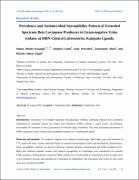Prevalence and Antimicrobial Susceptibility Pattern of Extended Spectrum Beta Lactamase Producers in Gram-negative Urine Isolates at MBN Clinical Laboratories, Kampala Uganda
Date
2018Author
Kasango, Simon Dembe
Lutoti, Stephen
Wewedru, Izale
Aboce, Emmanuel
Angol, Denish Calmax
Metadata
Show full item recordAbstract
Introduction: Occurrence of Extended Spectrum beta-lactamase (ESBLs) producing bacteria have presented
impediment in treatment choices for urinary tract infections. ESBLs embody a major cluster of lactamases
accountable for resistance to novel generations of ß-lactam drugs worldwide. The study determined prevalence of
ESBL organisms in urine isolates and susceptibility patterns to 13 antibacterial agents.
Materials and methods: Two hundred samples were cultured on blood agar, MacConkey agar and incubated at
37°C utmost 48 hours. Isolates identified based on standard bacteriological culture and biochemical characteristics.
Drug susceptibility centered on Clinical Laboratory Standard Institute recommended and WHO modified Kirby-
Bauer disc diffusion methods. Isolates with reduced susceptibility to Ceftazidime were considered to be possible
ESBL producers. Phenotypically confirmed ESBL required use of Ceftazidime in combination with Clavulanic acid.
A five milimeter increase zone diameter for Ceftazidime in combination with Clavulanic acid versus its zone tested
alone was considered as ESBL. Results: Out of 200 samples, 45 (22.5%) had significant growth, majority Escherichia coli 28 (62.2%), Klebsiella
pneumonae 11 (24.4%) followed and Citrobacter fruendii 2 (4.4%). Enterobacter species, Morganella morganii,
Proteus mirabilis and Seratia marcescens each 1 (2.2%). Prevalence of ESBLs was 56%. Out of 25 (56%) ESBLs,
highest prevalence was among Escherichia coli (15/25; 60%) followed by Klebsiella pneumonae (5/25; 24%) while
Citrobacter fruendii, Enterobacter species, Morganella morganii and Proteus mirabilis each had (1/25; 4%).
Susceptibility was highest to Imipenem 22 (88%) and least to Ampicillin, Amoxicillin-Clavulanic acid and
Tetracycline each 1 (4%). No susceptibility to Cefuroxime and Ceftazidime was observed.
Conclusion: The study showed that resistant ESBLs generating bacteria were present among urine isolates. We
recommend that ESBLs bacteria isolated in urine be treated based on antibiotics susceptibility, continuous
surveillance to guide correct treatment for urinary tract infection and to prevent the occurrence of multi drug
resistant bacteria. This should be reflected in the policies developed by the Ministries of health to promote rational
use of antibiotics.

